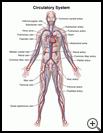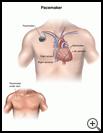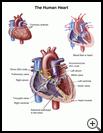
Electrocardiography
What is electrocardiography?
Every normal heartbeat starts in a group of special pacemaker cells in the upper right chamber of the heart. These cells send a regular electrical signal that causes the heart to contract (squeeze) and push blood into other parts of the heart and out to the body. Electrocardiography (also called ECG or EKG) is a painless test that shows the electrical activity of the heart. It can be done to check how strong and regular or irregular your heart is beating, measure the heart rate, and show damage to the heart muscle. It can also be done to check how well heart medicines or a heart pacemaker is working.
How is electrocardiography done?
Before the test:
Usually no preparation is necessary for an ECG. The test is usually done while you rest in your hospital bed.
During the test:
Small, sticky pads will be placed on the skin of your chest, arms, and legs. Long wires, called leads, will be attached to the pads and connected to a recording machine. You will be asked to be still and quiet for a few minutes while the machine records the electrical activity of your heart.
After the test:
- There is no special recovery needed after the ECG is done.
- You may stay in the hospital for a few hours or several days, depending on your condition and your test results.
- While you are in the hospital, you will be checked often by nursing staff.
Your provider will use your test results to make a plan for your care.
How can I take care of myself when I go home?
Call emergency medical services or 911 if you have new or worsening:
- Chest pain or pressure, squeezing, or fullness in the center of your chest that lasts more than a few minutes, or goes away and comes back (may feel like indigestion or heartburn)
- Pain or discomfort in one or both arms or shoulders, or in your back, neck, jaw, or stomach
- Trouble breathing
- Breaking out in a cold sweat for no known reason
- Along with the previous symptoms, feeling very tired, faint, or sick to your stomach
- Feeling like your heart is beating too fast, too slow, or skipping beats
What does the test result mean?
This test is only one part of a larger picture that includes your medical history and current health. Talk to your healthcare provider about your result and any follow up care you may need.
If your test results are not normal, ask your healthcare provider:
- If you need additional tests
- If you need treatment, and if so what your treatment plan choices are
- If you need to make any lifestyle changes to keep your heart healthy
Last modified: 2014-07-30
Last reviewed: 2015-05-28



